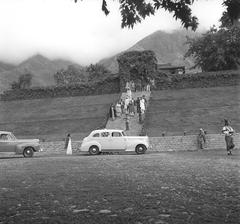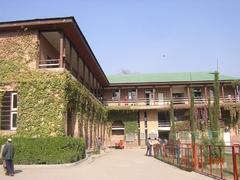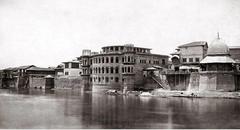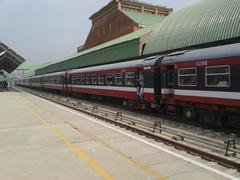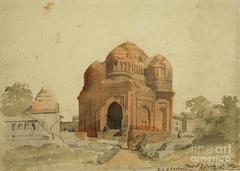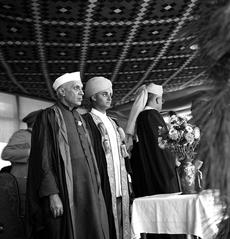Pathar Masjid Srinagar: Visiting Hours, Tickets, and Historical Significance
Date: 14/06/2025
Introduction
Pathar Masjid, located on the banks of the Jhelum River in Srinagar, Jammu and Kashmir, stands as a unique testament to Mughal-era stone architecture and the region’s layered cultural history. Commissioned in 1623 CE by Empress Noor Jahan during Emperor Jahangir’s reign, the mosque is renowned for its distinctive use of locally sourced grey limestone—a marked departure from Kashmir’s traditional wooden mosques. Its austere yet elegant design, highlighted by a flat roof and nine pointed arches, demonstrates a harmonious blend of Persian, Mughal, and indigenous Kashmiri architectural elements. Today, Pathar Masjid is both an active place of worship and a celebrated heritage monument, drawing historians, architecture enthusiasts, and travelers from around the world (Cultural India; Srinagar Tourism; specialplacesofindia.com).
Historical Overview
Origins and Patronage
Constructed in 1623, Pathar Masjid—literally “Stone Mosque”—was commissioned by Noor Jahan, the influential consort of Emperor Jahangir. Her refined artistic vision shaped the mosque’s design, reflecting both imperial aspirations and local sensibilities. Unlike the region’s typical wooden mosques, Pathar Masjid’s robust limestone construction was a deliberate statement of permanence and Mughal authority—a decision that set it apart both visually and symbolically (Cultural India; makemytrip.com).
Mughal Influence and Architectural Innovation
Noor Jahan’s patronage was instrumental in the mosque’s design, which incorporates Persian elements such as pointed arches and a symmetrical layout. Measuring approximately 180 feet long and 51 feet wide, the mosque’s façade is defined by nine arches—each supported by massive piers and set upon a raised plinth. The flat roof, a notable deviation from the domed Mughal mosques of the plains, aligns with practical Kashmiri architectural traditions and climate considerations (Live History India; Incredible India).
Historical Context and Religious Usage
Although initially intended as a place of worship for Srinagar’s Shi’a Muslim community, Pathar Masjid’s religious function was interrupted soon after its completion, following local opposition and shifting political dynamics. For centuries, it was relegated to secular uses, such as storage. It was only in the early 20th century that the mosque was restored to its original spiritual purpose, symbolizing resilience within Kashmir’s evolving socio-political landscape (Wikipedia; TravelTriangle).
Architectural Features
Layout and Structure
Pathar Masjid’s rectangular plan is oriented westward, facing Mecca. The spacious prayer hall is devoid of a central dome, instead featuring a flat roof upheld by a series of arches and pillars. The nine pointed arches on the façade—key architectural highlights—are framed by shallow niches and punctuate the mosque’s otherwise austere exterior. The mosque’s interior is marked by simplicity, with minimal adornment to showcase the natural beauty of the stone (specialplacesofindia.com).
Materials and Construction Techniques
The use of locally quarried grey limestone grants the mosque both durability and a distinctive aesthetic. The massive stone blocks were meticulously cut and assembled with minimal mortar, showcasing the technical prowess of Mughal craftsmen. Deep foundations and thick walls were designed to withstand the marshy riverbank terrain and frequent regional earthquakes (specialplacesofindia.com).
Symbolism and Style
The mosque’s restrained ornamentation and harmonious proportions highlight the Mughal affinity for balance and symmetry. The central, larger arch serves as a symbolic gateway to the divine, while the flat roof and pointed arches reflect a confluence of Persian, Mughal, and local Kashmiri influences (Archnet).
Religious and Cultural Significance
Pathar Masjid’s layered history mirrors the region’s complex religious and cultural dynamics. Its stone construction was both a technical innovation and an assertion of Mughal power. Following its reconversion in the 20th century, Pathar Masjid once again serves as a place of worship—particularly for the Shi’a Muslim community—hosting daily prayers and special gatherings during Islamic festivals (TravelTriangle; Holidify).
The mosque’s proximity to other major religious sites, such as Khanqah-e-Moula and Jama Masjid, underscores its role within Srinagar’s vibrant spiritual landscape and its broader significance as a cultural monument.
Visiting Pathar Masjid: Hours, Tickets, and Practical Information
Visiting Hours
Pathar Masjid is open daily to visitors, typically from 8:00 AM to 6:00 PM. During religious holidays or special events, hours may vary, so it is advisable to check locally or consult with caretakers before visiting.
Entry Fees and Tickets
Entry to Pathar Masjid is free for all visitors. Donations for the mosque’s upkeep and ongoing restoration are appreciated.
Accessibility
The mosque is centrally located in Srinagar’s Nowhatta area, easily accessible by taxi, auto-rickshaw, or local bus. The terrain near the riverbank can be uneven, and there are currently limited facilities for visitors with disabilities.
Dress Code and Visitor Etiquette
- Modest dress is required: women should cover their heads and wear clothing that covers arms and legs; men should wear long trousers and shirts.
- Shoes must be removed before entering the prayer hall.
- Photography is generally allowed, but visitors should seek permission before photographing worshippers or religious ceremonies.
- Silence and respectful behavior are expected, especially during prayers.
Best Time to Visit
Spring and autumn offer the most pleasant weather and are ideal for both sightseeing and photography. Early mornings and late afternoons provide the best natural lighting and a quieter atmosphere.
Guided Tours
While there is no official on-site guide service, local tour operators and heritage organizations may offer guided walks that include Pathar Masjid as part of a broader exploration of Srinagar’s historical sites.
Nearby Attractions
Visitors are encouraged to explore other nearby landmarks, such as Khanqah-e-Moula, Jamia Masjid, Shankaracharya Temple, and the Mughal Gardens (Shalimar and Nishat). These sites offer further insight into the region’s diverse spiritual and architectural heritage.
Conservation and Restoration Efforts
Pathar Masjid has recently been the focus of significant conservation initiatives led by the Jammu & Kashmir Wakf Board and the Archaeological Survey of India (ASI). Ongoing efforts include cleaning and conserving the limestone façade, reinforcing structural elements, restoring historical inscriptions, upgrading visitor amenities, and improving interpretive signage (Awaz The Voice; INTACH Kashmir). These measures aim to ensure both the mosque’s preservation as a living place of worship and its accessibility as a cultural monument.
Frequently Asked Questions (FAQs)
Q: What are the visiting hours for Pathar Masjid?
A: Typically, the mosque is open daily from 8:00 AM to 6:00 PM. Hours may vary during religious events.
Q: Is there an entry fee?
A: No, entry is free. Donations are welcome.
Q: Are non-Muslim visitors allowed?
A: Yes, all visitors are welcome, but should dress modestly and respect religious practices.
Q: Are guided tours available?
A: Local guides and tour operators may offer tours; there is no official on-site guide.
Q: Can I take photographs inside?
A: Photography is generally permitted, but always ask before photographing worshippers.
Q: Is Pathar Masjid accessible for people with disabilities?
A: Accessibility is limited due to uneven terrain and lack of dedicated facilities.
Q: What are the best nearby attractions to combine with a visit?
A: Khanqah-e-Moula, Jamia Masjid, Mughal Gardens, and the Old City markets.
Conclusion
Pathar Masjid stands as a distinctive symbol of Srinagar’s Mughal architectural heritage and cultural syncretism. From its striking limestone construction and serene riverside setting to its layered religious history and ongoing restoration, the mosque offers visitors a unique window into Kashmir’s past and present. Whether you are a history enthusiast, architecture lover, or spiritual seeker, a visit to Pathar Masjid promises a tranquil and enriching experience. Respect local guidelines, embrace the mosque’s quiet beauty, and consider exploring nearby landmarks to deepen your understanding of Srinagar’s diverse heritage.
For the latest updates on visiting hours, restoration progress, and guided tours, consult official tourism portals, the Jammu & Kashmir Wakf Board, or download the Audiala app.
Enhance your Srinagar experience by downloading the Audiala app for real-time updates on heritage sites. Follow us on social media for travel inspiration and insider tips.
References
- Pathar Masjid Srinagar: Visiting Hours, Tickets, and Historical Significance, 2024, Cultural India (https://www.culturalindia.net/monuments/pathar-masjid.html)
- Pathar Masjid Srinagar, 2024, Srinagar Tourism (https://www.srinagartourism.com/pathar-masjid-srinagar)
- Pathar Masjid Visitor Guide, 2024, specialplacesofindia.com (https://specialplacesofindia.com/jammu-kashmir-monuments/)
- Pathar Masjid Srinagar, 2024, Wikipedia (https://en.wikipedia.org/wiki/Pathar_Mosque)
- Wakf to Restore Neglected Year Pathar Masjid in Srinagar, 2024, Awaz The Voice (https://www.awazthevoice.in/heritage-news/wakf-to-restore-neglected-year-pather-masjid-in-srinagar-28317.html)
- Pathar Masjid Heritage Site Conservation, 2024, INTACH Kashmir (https://www.intachkashmir.org/heritage-sites/pathar-masjid/)
- Pathar Masjid in Mughal Architecture, 2024, Archnet (https://archnet.org/sites/3772)
